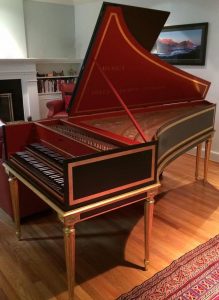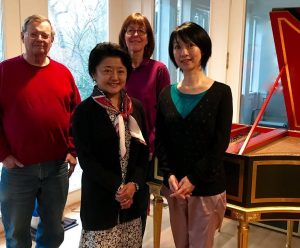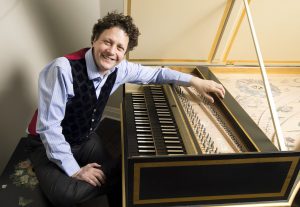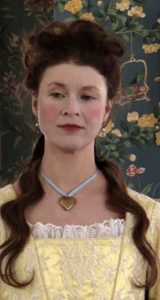This story features “Baroque Elegance” presented by Capriccio Baroque. Learn more about this performance and get tix on the event page here.

Carolyn Winter once thought her proficiency on the piano would make the harpsichord a “quick and easy” second instrument for her to learn to play in her newly acquired free time.
“It turns out I was profoundly wrong on this count,” she admitted, acknowledging that she quickly learned that the two keyboard instruments had far more differences than similarities.
“The harpsichord is a much more difficult instrument to play,” Winter said. “It is much more exacting in what it demands of the player—precision is paramount.”
Now, Winter—an accomplished pianist who has been immersed in music, mostly piano and choir, since age 8 in her native Zimbabwe–can count the ways the two instruments differ. “The harpsichord effectively has no dynamic range– or very, very little. Imagine a piano being played without loud and soft swells of sound – it would be dull and unemotional. This is what the harpsichord sounds like when played by a beginner. So, the task of the harpsichordist is one of smoke and mirrors – to trick the listener into believing that they’re hearing dynamic range. To do this, players learn many different forms of ornamentation that effectively fancy up the music and, in a way, serve as lovely ‘distractions.’ …This is very tricky to do well.”
In addition, she said, the lack of a foot pedal on the harpsichord means that “swellings of dynamic sound must be made through finger technique,” and the harpsichord’s strings are plucked rather than hit as in the piano, which “accounts for the considerable difference in sound between the instruments and requires different playing techniques.”

Prior to acquiring this knowledge, Winter acted on the recommendations of the professional harpsichordists she consulted and purchased a Ruckers Ravallement, “a very expensive instrument with a beautiful sound.” The harpsichord, which has two keyboards, was built by the “dean of American harpsichord building, William Dowd, in 1972,” and its “decoration (is) reportedly a fine example of the American Revival style—gold leaf decoration, fluted legs, Latin inscription on the lid,” she said. Adding to its value, she noted, John Lewis, the African American leader of the Modern Jazz Quartet, commissioned its creation and used it in many classical and jazz recordings.
Once Winter began taking harpsichord lessons, she “realized that I had gravely underestimated what was involved. I began to feel increasingly guilty owning a gorgeous instrument that I couldn’t do justice to. … I found myself thinking that this glorious instrument deserved to be played by someone really good, not just by the extreme novice I was.”

Thus, Winter came up with the “idea of starting a harpsichord concert series. I’d get really good people to play my really good instrument.” She teamed up with a neighbor who also had a harpsichord to from Aberfoyle (the street they lived on) Baroque, which produced two seasons during which “we steadily grew an audience.” Aberfoyle was closed, Winter said, because it was an LLC and the two principals “had different visions about where to take it and because they differed in the time and energy available to invest in it.”
Winter proceeded to establish Capriccio Baroque as a nonprofit; in addition, although “it very decidedly continues the focus on the harpsichord as a solo instrument, it also occasionally brings in other associated Baroque arts, mainly voice and dance.” The Sunday, March 18, concert at Woodend Mansion in Chevy Chase, titled “Baroque Elegance: A Beautiful Evening of Solo Harpsichord Works and Baroque Dance Pieces,” will feature harpsichordist Jory Vinikour, a two-time Grammy nominee, in a program of solo harpsichord works by Rameau, Handel, Bach and Scarlatti, and Baroque dance pieces along with Baroque dancer Caroline Copeland in period-informed costume.
Vinikour looks forward to playing the “beautiful harpsichord,” which will be “a treat both to play and to hear.” While his solo pieces “generally evoke the idea of dance, such as the great ‘Chaconne with Variations’ by Handel,” the selections he will perform with Copeland “were very carefully chosen, based on her desires, and also designed to show off harpsichord and harpsichordist.”

“The audience should expect beauty and grace” from Copeland’s “one-woman ballet,” Vinikour said. “There is such great detail, and every movement and gesture are imbued with meaning.” Last year in Berkeley, he noted, when Copeland “was the lead dancer in the very elaborate production of Jean-Philippe Rameau’s ‘Temple de la Gloire,’ with the Philharmonia Baroque Orchestra, conducted by Nicholas McGegan, Vinkour served as the assistant “who played at all rehearsals.” Although he has not given a recital “as such” with a Baroque dancer, he said that during that month-long experience, “I certainly garnered a bit of extra knowledge.”
Among Winter’s goals for Capriccio, she said, is “to try to build more interest in Baroque dance,” which she said is little known in the metro area “and is so very beautiful.”
“I chose the name ‘Capriccio’ because it is a music term derived from early 17th century words. Specifically, it denotes a “sudden change of mind” (World Bank to Harpsichord Concert series),” Winter explained, adding, “Of course, the English version of Capriccio is ‘caper,’ a rather frivolous step or jump. Capriccio Baroque is, for me, a delightful, joyful, gamble.”
What distinguishes the concerts, beyond their content, is that Winter “intentionally keeps the audience very small and does my best to establish a personal feel. These concerts are very, very rare opportunities to hear some of the most accomplished performers in the harpsichord and early music world perform in a tiny, intimate setting.

“These are deeply personal experience because the artistry and emotion of the performers is so very tangible to the audience in that proximity. They are designed to be musical and social gatherings, far from the large, rather sterile world of mega concert halls.”
Capriccio does not make a profit or even break even and Winter does not get a salary. “That’s not the point,” Winter said. “The enjoyment from this is offering others the chance to hear and appreciate this gorgeous instrument, to hear the beautiful music written specially for the instrument, and to hear the instrument played by the very best harpsichord performers.
“I enjoy the concerts for the same reasons that others do. And, in the course of all this, I can be happy that my instrument is being played by someone worthy of it—and not just be a ran beginner like me!”
Capriccio Baroque will present “Baroque Elegance: A Beautiful Evening of Solo Harpsichord Works and Baroque Dance Pieces,” featuring harpsichordist Jory Vinikour and Baroque dancer Caroline Copeland, from 5:30 to 7 p.m. on Sunday, March 18, at Woodend Mansion and Sanctuary, 8490 Jones Mill Road, Chevy Chase. For tickets–$80, $85 for premier view seats, visit www.capricciobaroque.org. Ticket purchase includes a complimentary after-party with canapés and fine wines. No tickets will be sold at the door.